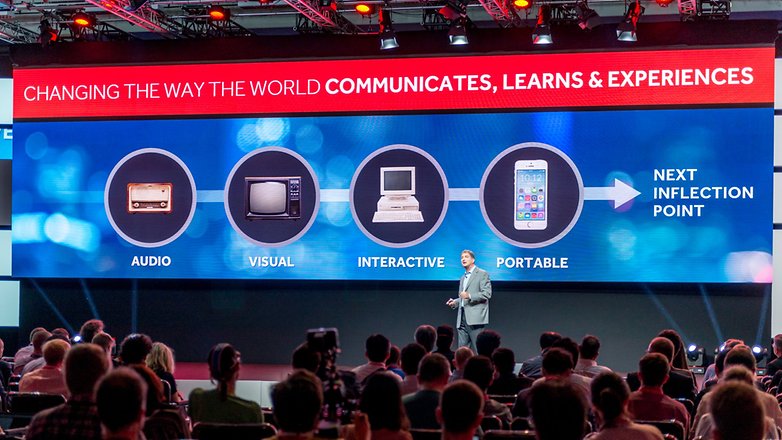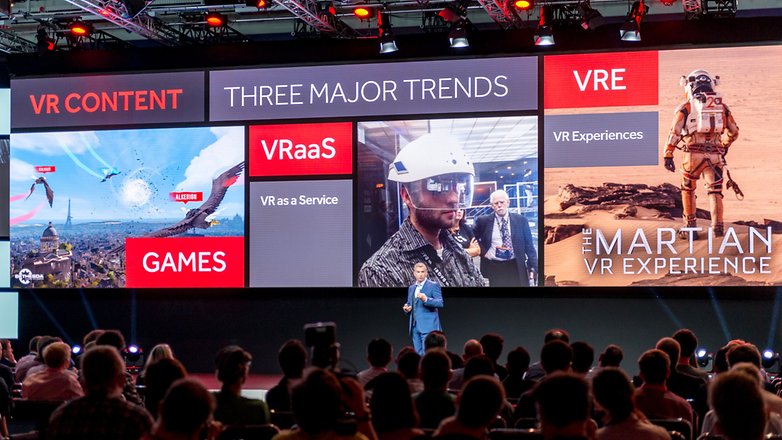The famous high-tech company AMD was there at the IFA. The company’s tech manager, Mark Papermaster, took the time to talk with many of the invitees to explain his concept of virtual reality and how he imagines its future. His comments were perplexing; despite the incredible enthusiasm I have towards VR, everything he said just reinforced my doubts and questions about the subject.
A gradual evolution
For many of us, virtual reality seems like a technology that came from nowhere. Barely 10 years after the arrival of smartphones and already here we are, diving into another reality. (Though we now have to replace things in this new context.)
AMD explained the history of communication technology. It all started with audio material, or, more specifically, radio, which allowed us to hear someone from a distance. Following this, we were launched into a different perspective: audio accompanied by video, all thanks to television. Later on, computers made it possible to communicate interactively with audio and video, opening our eyes to–among other things–very promising potential new technology. Today we live in the era of smartphones, which, in the age of innovation, takes all of the elements that preceded it and puts them together in a single device.

Now that it’s possible to be connected at any given moment in a number of different ways in our own reality, rendered (too?) classic thanks to technology, we can also take a step forward and plunge into a new kind of reality.
A huge market with a lot to offer
The concept of VR is to thrust us into another reality, a reality created by application developers and made accessible to us through specific helmets that give us the chance to experience marvelous new worlds. AMD used the term “full presence environment” to describe the representation of reality that we can have with our own eye. They talk about wanting to get as close as possible, to be able to immerse a user completely in a virtual environment.

The most obvious function of virtual reality is in games. Who has never dreamed of being totally present inside a game, not just playing as a spectator behind a screen? This is actually possible with VR. But VR will have other uses too, especially in professional settings. A medical student will be able to act out a surgery simulation to test his skills, as just one example. For other average Joe’s, it’s a way to visit another country without leaving the couch.
Regardless of what skeptics may say, VR has already arrived. Its industry brings together all sorts of people working on its various components, helmets and applications, which comprise an entire universe surrounding this technology.
But we’ve still got a long road ahead…
AMD hopes to see VR primed and ready to be used by all. Their intentions are reasonable (though certainly motivated by profit), but we are far from being at this point. First and foremost, VR is, by nature, a relatively complicated technology that requires sophisticated technological material in order to rapidly process images. Even though progress in this field is constant and we are already being rewarded with relatively advanced helmets (there are already some pretty good games in VR!), the road to having the technology that we really want remains long.
Video games and film, we hope, should open our eyes to popular virtual reality. But to attract users, we need content. And to create content, users need to show an initial interest. This vicious circle is difficult to tackle despite all of the public’s enthusiasm in regards to this technology. There are also other additional problems: some people have migraines induced by VR. And what’s with people who wear glasses? They can’t exactly wear the helmet…

Smartphone users shouldn’t be the only ones able to use this technology. AMD has a few proposals for those who want to access VR straight from their computers; they would just need to connect an accordingly-adapted helmet. There you can enter into another dimension, with a graphic map that costs roughly as much as a computer…but then you also have to add the price of the helmet itself. As we’ve said, we are far from a world in which VR is feasibly accessible by all. Of course, high-tech has its price, but the current price is attractive only to niche users, and many would still rather pass than pay enormous sums for this technology.
Those who frequently read my articles know that I tend to touch on the social aspect of technology, and this article is no exception to this rule. I’m not the first to marvel at the technological prowess that we’re capable of creating today, but I have to ask myself again why we even need (it really does seem to be a ‘need’ rather than a ‘want’) to escape into another reality. “Because we can and because it’s cool” is the most down-to-earth response I get. But the problem likely goes deeper than that.
No comments:
Post a Comment